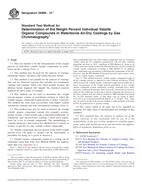Potřebujeme váš souhlas k využití jednotlivých dat, aby se vám mimo jiné mohly ukazovat informace týkající se vašich zájmů. Souhlas udělíte kliknutím na tlačítko „OK“.
ASTM D6886-14e1
Standard Test Method for Determination of the Weight Percent Individual Volatile Organic Compounds in Waterborne Air-Dry Coatings by Gas Chromatography (Includes all amendments And changes 10/29/2018).
Automaticky přeložený název:
Standardní zkušební metoda pro stanovení hmotnostní procenta jednotlivých těkavých organických látek v Vodou ředitelný Air-Dry Coatings plynovou chromatografií
NORMA vydána dne 15.6.2014
Informace o normě:
Označení normy: ASTM D6886-14e1
Poznámka: NEPLATNÁ
Datum vydání normy: 15.6.2014
Kód zboží: NS-36866
Počet stran: 9
Přibližná hmotnost: 27 g (0.06 liber)
Země: Americká technická norma
Kategorie: Technické normy ASTM
Kategorie - podobné normy:
Anotace textu normy ASTM D6886-14e1 :
Keywords:
gas chromatography, speciation, volatile organic compounds, waterborne coatings, ICS Number Code 71.040.50 (Physicochemical methods of analysis)
Doplňující informace
| Significance and Use | ||||||||||||||||||||||||
|
5.1 In using Practice D3960 to measure the volatile organic compound content of waterborne coatings, precision can be poor for low volatile organic compound content air-dry coatings if the volatile organic weight percent is determined indirectly. The present method directly identifies and then quantifies the weight percent of individual volatile organic compounds in air-dry coatings (Note 6). The total volatile organic weight percent can be obtained by adding the individual weight percent values (Note 7). Note 6: The present method may be used to speciate
solvent-borne air-dry coatings. However, since these normally
contain high, and often complex, quantities of solvent, precision
tends to be better using other methods contained in Practice
D3960, where the volatile
fraction is determined by a direct weight loss
determination.
Note 7: Detectable compounds may result from thermal
decomposition in a hot injection port or from reaction with the
extraction solvent. If it can be shown that a material is a
decomposition product, or is the result of a reaction with the
extraction solvent, then results for that compound should be
discounted from the volatile measured by Test Method D6886.
|
||||||||||||||||||||||||
| 1. Scope | ||||||||||||||||||||||||
|
1.1 This test method is for the determination of the weight percent of individual volatile organic compounds in waterborne air-dry coatings (Note 1). 1.2 This method may be used for the analysis of coatings containing silanes, siloxanes, and silane-siloxane blends. 1.3 This method is not suitable for the analysis of coatings that cure by chemical reaction (this includes two-component coatings and coatings which cure when heated) because the dilution herein required will impede the chemical reaction required for these types of coatings. 1.4 This method can be used to determine the weight percent organic content of waterborne coatings in which the volatile organic compound weight percent is below 5 percent. The method has been used successfully with higher content waterborne coatings and with solventborne coatings (Note 2). 1.5 This method may also be used to measure the exempt volatile organic compound content (for example, acetone, methyl acetate, t-butyl acetate and p-chlorobezotrifluoride) of waterborne and solvent-borne coatings. Check local regulations for a list of exempt compounds. The methodology is virtually identical to that used in Test Method D6133 which, as written, is specific for only exempt volatile compounds. 1.6 Volatile compounds that are present at the 0.005 weight percent level (50 ppm) or greater can be determined. A procedure for doing so is given in Section 9. 1.7 Volatile organic compound content of a coating can be calculated using data from Test Method D6886 but requires other data (see Appendix X2.) Note 1: Data from this method will not always provide the
volatile organic compound content of a paint film equivalent of EPA
Method 24. Some compounds and some semi-volatile compounds may be
considered volatile using the GC conditions specified but will not
fully volatilize during the one hour at 110°C conditions of EPA
Method 24. Some or all of these materials remain in the paint film
and therefore are not considered volatile organic compounds
according to EPA Method 24. In addition, some compounds may
decompose at the high inlet temperature of the GC. However, note
the EPA Method 24 has poor precision and accuracy at low levels of
volatile organic compounds.
Note 2: This method measures volatile organic compound weight
of air-dry coatings directly as opposed to other methods in
Practice D3960 which measure
the volatile organic compound weight percent indirectly. A direct
measurement of the weight percent particularly in low volatile
organic compound content waterborne coatings, generally gives
better precision. California Polytechnic State University carried
out an extensive study for the California Air Resources Board
comparing the precision of the direct method with the indirect
method (CARB Standard Agreement No. 04.329) Detailed results of
this study may be found at
http://www.arb.ca.gov/coatings/arch/Final_Report_6_11_09.pdf. This
study may be used to decide if the present method or other methods
in Practice D3960 are
preferred for a specific coating.
1.8 The values stated in SI units are to be regarded as standard. No other units of measurement are included in this standard. 1.9 This standard does not purport to address all of the safety concerns, if any, associated with its use. It is the responsibility of the user of this standard to establish appropriate safety and health practices and determine the applicability of regulatory limitations prior to use. |
||||||||||||||||||||||||
| 2. Referenced Documents | ||||||||||||||||||||||||
|



 Cookies
Cookies
